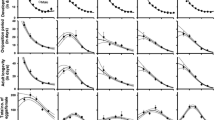Abstract
Demographic analysis of Tetranychus urticae under photoperiods of 12L:12D, 14L:10D and 18L:6D at 75% relative humidity and 25 °C showed that the developmental time and oviposition per female declined with increasing light period. The nymph, oviposition and adult stages were significantly shortened, resulting in shorter generation duration and faster population decline, but there was no effect on egg and larval stages of T. urticae. Kaplan–Meier survival analysis followed by a log-rank test indicated that the mean and median survival times were 40.4 (12:12), 39.1 (14:10), and 38.1 (18:6) days, and 42.0, 40.0, 39.0 days, respectively—this difference among photoperiods was significant. The total number of eggs per female under the three photoperiods was 69.63 (12:12), 77.44 (14:10) and 42.17 (18:6), respectively, and the sex ratios were 70.0, 81.6 and 71.6% female offspring. Under 14 h light, T. urticae experienced its highest net reproductive rate (R0 = 83.0577), intrinsic rate of increase (rm = 0.2740), finite rate of increase (λ = 1.3153), lowest mean generation time (T = 16.1277 days) and population doubling time (Dt = 2.5294 days). All demographic parameters displayed a decreasing relationship with the light phase under the three photoperiods. No significant difference in susceptibilities to the acaricides diafenthiuron and propargite was shown among the three photoperiods. The results of this study indicated that the 14L:10D photoperiod was optimal for the development and reproduction of T. urticae, and the 18L:6D period was disadvantageous for spider mite development.



Similar content being viewed by others
References
Auger P, Migeon A, Ueckermann EA, Tiedt L, Navajas M (2013) Evidence for synonymy between Tetranychus urticae and Tetranychus cinnabarinus (Acari, Prostigmata, Tetranychidae): review and new data. Acarologia 53(4):383–415
Bryon A, Wybouw N, Dermauw W, Tirry L, Van Leeuwen T (2013) Genome wide gene-expression analysis of facultative reproductive diapause in the two-spotted spider mite Tetranychus urticae. BMC Genomics 14:815
Ding YQ (1994) Insect mathematic ecology. Science Press, Beijing, pp 153–170
FAO (1980) Recommended methods for measurement of pest resistance to pesticide. Recommended methods for measurement of resistance to pesticides. Paper 21, pp 49–54
Hori Y, Numata H, Shiga S, Goto SG (2014) Both the anterior and posterior eyes function as photoreceptors for photoperiodic termination of diapause in the two-spotted spider mite. J Comp Physiol A 200:161–167
Ito K, Fukuda T, Hayakawa H, Arakawa R, Saito Y (2013) Relationship between body colour, feeding, and reproductive arrest under short-day development in Tetranychus pueraricola (Acari: Tetranychidae). Exp Appl Acarol 60:471–477
Kozai T, Ohyama K, Chun C (2006) Commercialized closed systems with artificial lighting for plant production. In: V International Symposium on Artificial Lighting in Horticulture, vol 711, pp 61–70
Li YJ (2013) Study of experimental population ecology of Eotetranychus kankitus (Ehara). Southwest University, Chongqing, pp 51–58
Meng RX, Liu JX, Yang BS, Zhao JX, Meng HW (2001) Effects of photoperiod on development and fecundity of Tetranychus truncatus Ehara (Acarina, Tetranychydae). Acta Agric Boreal Sin 16:113–118
Sparks TC, Nauen R (2015) Irac: mode of action classification and insecticide resistance management. Pestic Biochem Phys 121:122–128
Suzuki T, Takeda M (2009) Diapause-inducing signals prolong nymphal development in the two-spotted spider mite Tetranychus urticae. Physiol Entomol 34:278–283
Suzuki T, Amano H, Goto E, Takeda M, Kozai T (2007) Effects of extending the light phase on diapause induction in a japanese population of the two-spotted spider mite, Tetranychus urticae. Exp Appl Acarol 42:131–138
Suzuki T, Izawa N, Takashima T, Watanabe M, Takeda M (2009a) Action spectrum for the suppression of arylalkylamine n-acetyltransferase activity in the two-spotted spider mite Tetranychus urticae. Photochem Photobiol 85:214–219
Suzuki T, Watanabe M, Takeda M (2009b) UV tolerance in the two-spotted spider mite, Tetranychus urticae. J Insect Physiol 55:649–654
Tanaka M, Yase J, Aoki S, Sakurai T, Kanto T, Osakabe M (2016) Physical control of spider mites using ultraviolet-b with light reflection sheets in greenhouse strawberries. J Econ Entomol 109:1758–1765
Van Leeuwen T, Vontas J, Tsagkarakou A, Dermauw W, Tirry L (2010) Acaricide resistance mechanisms in the two-spotted spider mite Tetranychus urticae and other important acari: a review. Insect Biochem Mol 40:563–572
Wu QH, Ding ZR (1985) Influence of light on the growth and development of Tetranychus cinnabarinus. Chin J Ecol 4:22–26
Yong XJ, Zhang YQ, Ding W (2011) Sublethal effects of scopoletin on the experimental population of the carmine spider mite, Tetranychus cinnabarinus (Boisduval) (Acari: tetranychidae). Acta Entomol Sin 54:1377–1383
Acknowledgements
The authors would like to thank Hongying Jian, Qigang Wang (Flower Research Institute, Yunnan Academy of Agricultural Sciences, China) for providing mite samples for experimental tests. The research was funded by the National Natural Science Foundation of China (Nos. 31560520, 31201546), the Science and Technology Foundation of Yunnan Province (No. 2017HB059) and the Modern Agro-Industry (Sericulture) Technology Research System of China (No. CARS-22-SYZ27).
Author information
Authors and Affiliations
Corresponding author
Additional information
Publisher's Note
Springer Nature remains neutral with regard to jurisdictional claims in published maps and institutional affiliations.
Rights and permissions
About this article
Cite this article
Yang, Z., Shen, X., Ni, J. et al. Effect of photoperiods on development and acaricide susceptibility in the two-spotted spider mite, Tetranychus urticae. Exp Appl Acarol 80, 17–27 (2020). https://doi.org/10.1007/s10493-019-00434-9
Received:
Accepted:
Published:
Issue Date:
DOI: https://doi.org/10.1007/s10493-019-00434-9




